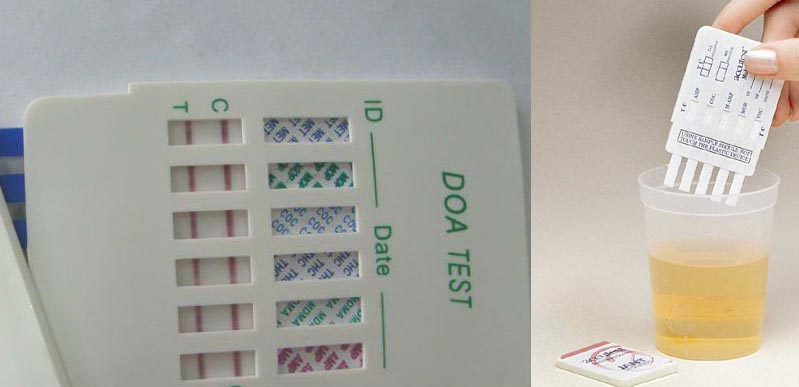What Does a 5 Panel Drug Test tests for? What's inside urine drug test?
If your employer spot-checks staff using a 5 panel drug test or 10-panel drug test, this means that technology is used which can test for different illegal substances and abuse drugs.
The most commonly consumed street drugs are cocaine, marijuana, amphetamines, basic opiates such as heroin, and PCP. The traditional standard urine test tests for these 5 health Street’s most basic drug.
- The following drugs are included in most available 5 panel urine drugs test:
- Cocaine, Crack.
- Marijuana, THC, cannabinoids, pot, weed.
- Phencyclidine, PCP, angel dust.
- Amphetamines, methamphetamines, meth, crystal meth.
- Heroin, codeine, morphine.
Drug screen is for pre-employment screen and drugs of abuse
Specimen: 30ml random urine
There are commercially available 4 Parameter Multiline Cassette Drugs of Abuse Test, Multi Panel Drugs of Abuse RapiCard™ (Cassette), SureStep™ Drug Screen Cassette – Alere, and others
Medical codes for abuse drugs in 5-Panel Drug Tests are: THC-COC-OPI-AMP-mAMP
The medical code of drugs of abuse test is “DOA”
A common multi panel drug test in urine tests for:
- Amphetamines: Amphetamine is a potent central nervous system stimulant that is used in the treatment of attention deficit hyperactivity disorder, narcolepsy, and obesity. So that it can be used as abuse drug.
- Barbiturates: Barbiturates are drugs that act as central nervous system depressants, and can therefore produce a wide spectrum of effects, from mild sedation to total anesthesia. They are also effective as anxiolytics, hypnotics, and anticonvulsants.
- Benzodiazepines: Benzodiazepines or “benzos”, are a class of psychoactive drugs.
- Cannabinoids: substances acts on cannabinoid receptors in cells that alter neurotransmitter release in the brain.
- Cocaine: also known as coke, is a strong stimulant mostly used as a recreational drug. It is commonly snorted, inhaled, or injected into the veins
- Opiates: Opioids are substances that act on opioid receptors to produce morphine-like effects. Opioids are most often used medically to relieve pain.
- phencyclidine (angel dust): is a dissociative drug. PCP was brought to market in the 1950s as an anesthetic pharmaceutical drug but was taken off the market in 1965. Other drugs in same class: Ketamine, Memantine, Nitrous oxide, Amantadine, Riluzole. Drug class is NMDA receptor antagonist.

Read about: drugs cause liver pain and damage at: 33 drugs cause high liver enzymes and liver pain.
Please use the search feature to facilitate your search.
Benzodiazepines and the same class drugs:
Diazepam, Alprazolam, Clonazepam, Lorazepam, Midazolam, Chlordiazepoxide, Oxazepam, Flunitrazepam, Temazepam, Bromazepam, Flumazenil, Triazolam, Nitrazepam, Clobazam, Clorazepate, Flurazepam, Phenazepam, Estazolam, Lormetazepam, Brotizolam, Ethyl loflazepate, Tetrazepam, Nordazepam, Prazepam, Chlordiazepoxide/clidinium bromide, Medazepam, Tofisopam, Clotiazepam, Delorazepam, Loprazolam, Cloxazolam, Ketazolam, Meclonazepam, Mexazolam, Quazepam, Nimetazepam, Ro15-4513, Halazepam, Fludiazepam, Gidazepam, Flutoprazepam, Adinazolam, Oxazolam, Rilmazafone, Clorazepate Dipotassium, Pinazepam, Bretazenil, Chlordiazepoxide hydrochloride, Cinolazepam, Haloxazolam
Barbiturates and drugs in the same class include:
Phenobarbital, Sodium thiopental, Methohexital, Thiamylal, Butalbital/Acetaminophen/Caffeine, Butalbital/Acetaminophen, Butalbital/Aspirin/Caffeine, Methohexital sodium, Thiobarbital, Thiobutabarbital, Thialbarbital, Codeine/Butalbital/Caffeine/Aspirin, Codeine anhydrous/Butalbital/Caffeine/Acetaminophen
Cocaine and Other drugs in same class:
Cocaine classes: Dermatological – Topical Local Anesthetic Esters, Local anesthetic. Other is the same class:
Proparacaine
Lidocaine
Benzocaine
Procaine
Tetracaine
Mepivacaine
Prilocaine
Cinchocaine
Chloroprocaine
Tetracaine hydrochloride
Fluorescein/Proparacaine
Proparacaine hydrochloride
Proparacaine
Opiates include:
Morphine, Tramadol, Oxycodone, Fentanyl, Methadone, Naloxone, Hydrocodone/paracetamol, Hydromorphone, Oxycodone/paracetamol, Loperamide, Meperidine, Tapentadol, Oxymorphone, Propoxyphene, Remifentanil, Sufentanil, Alfentanil, Levorphanol, Oxycodone/aspirin, Morphine/naltrexone, Hydrocodone/ibuprofen, Morphine Sulfate, Oxycodone Hydrochloride, Fentanyl Citrate, Hydromorphone Hydrochloride, Methadone hydrochloride, Tramadol/Acetaminophen, Hydrocodone/Homatropine, Oxymorphone Hydrochloride, Propoxyphene Napsylate, Codeine/Guaifenesin, Propoxyphene/Acetaminophen, Hydrocodone/Chlorpheniramine, Loperamide Hydrochloride, Oxycodone/ibuprofen, Tapentadol hydrochloride, Meperidine Hydrochloride, Sufentanil citrate, Remifentanil hydrochloride, Levorphanol tartrate, Alfentanil Hydrochloride, Propoxyphene Hydrochloride, Hydrocodone/Pseudoephedrine, Acetaminophen/Caffeine/Dihydrocodeine, Dihydrocodeine/Aspirin/Caffeine, Hydrocodone/Homatropine methylbromide, Hydrocodone/Pseudoephedrine/Chlorpheniramine, Dihydrocodeine/Guaifenesin, Dihydrocodeine/Brompheniramine/Pseudoephedrine, Dihydrocodeine/Phenylephrine/Pyrilamine.
5 panel drug test results
Results are reported as +ve or -ve using internationally recognised cut-off limits.
Serum is not used for screening durgs of abuse.
If alcohol is required a blood (serum) specimen should be collected to give a quantitative result which will separate the prospective employee who had a health-giving glass of wine the night before from the chronic alcoholic with a sustained high alcohol level.
Pre-employment screens, common for some years in the USA, are being used more often now in New Zealand and in some occupations, for example in public transport, random checks may be used.
When results are to be used medico-legally, there has to be a secure audit trail beginning with direct observation of specimen collection.
When drugs seen in the urine drug test?
The half-life (t½) is the time for a serum level to drop by 50%. When a drug is started, or the dosage changed, the time to reach a new steady state = t½ x 5.
Reasons for drug monitoring include:
- check compliance
- guide dose adjustment
- check for toxicity
- monitor interactions if a new drug is added
- the choice of rehabilitation at clinics
Other types of drugs of abuse according to pharmacies:
Drug Scheduling in five categores:
Schedule I
Schedule II
Schedule III
Schedule IV
Schedule V
V. Narcotics
Heroin
Hydromorphone
Methadone
Morphine
Opium
Oxycodone
VI. Stimulants
Amphetamines
Cocaine
Khat
Methamphetamine
VII. Depressants
Barbiturates
Benzodiazepines
GHB
Rohyphol®
VIII. Hallucinogens
Ecstasy/MDMA
K2/Spice
Ketamine
LSD
Peyote & Mescaline
Psilocybin
IX. Marijuana/Cannabis
X. Steroids
XI. Inhalants
XII. Drugs of Concern
Bath Salts or Designer Cathinones
DXM
Kratom
Salvia Divinorum
It is impossible to cheat these drug tests. so that urine test are accurate enough.
5 panel urine drug test acts as an intervention if an addict is found to have excessive levels of alcohol or abuse drugs in his urine. For more interpretations follow up.
Read more about:
